Bowman F. Ashe (1926-52)
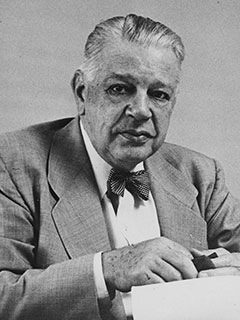 The University of Miami was chartered in 1925 by a group of citizens who felt an institution of higher learning was needed for the development of their young and growing community. By the fall of 1926, when the first class of 646 full-time students enrolled at the University of Miami, the land boom had collapsed and hopes for a speedy recovery were dashed by a major hurricane. In the next 15 years the University barely kept afloat. The University survived primarily due to the vision and persistence of its first president, Bowman F. Ashe (1926-52). Under his administration, the institution overcame bankruptcy, a reorganization, a world war, and then in the post-war years, experienced tremendous growth and expansion.
The University of Miami was chartered in 1925 by a group of citizens who felt an institution of higher learning was needed for the development of their young and growing community. By the fall of 1926, when the first class of 646 full-time students enrolled at the University of Miami, the land boom had collapsed and hopes for a speedy recovery were dashed by a major hurricane. In the next 15 years the University barely kept afloat. The University survived primarily due to the vision and persistence of its first president, Bowman F. Ashe (1926-52). Under his administration, the institution overcame bankruptcy, a reorganization, a world war, and then in the post-war years, experienced tremendous growth and expansion.
When the University opened in 1926, it consisted of the College of Liberal Arts, the School of Music, and the Evening Division. During the Ashe presidency, the University added the School of Law (1928), the School of Business Administration (1929), the School of Education (1929), the Graduate School (1941), the Marine Laboratory (1942; presently the Rosenstiel School of Marine and Atmospheric Science), the School of Engineering (1947), and the School of Medicine (1952). The major development shaping the post-World War II years was the G.I. Bill, which funded returning soldiers’ tuition and expenses. When the Fall 1946 semester commenced, more than 5,000 students registered. In 1948 the Memorial Building was dedicated, the first permanent building on the campus. Thanks to a $5 million Federal Housing Administration loan, 530 apartments were built on campus. The Merrick Building was finally completed in 1950.
Jay F. W. Pearson (1953-1962)
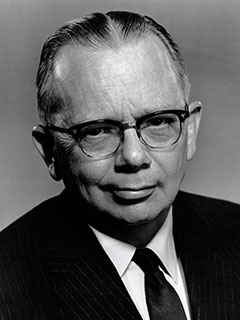 A marine biologist by training, charter faculty member, and an assistant to President Ashe since 1929, Jay F. W. Pearson assumed the presidency in 1953 and presided during a decade of unprecedented growth. Total enrollment stood at over 10,000 in 1953 and increased to nearly 14,000 by the end of the Pearson presidency in 1962. New facilities and resources were added to keep pace with enrollment and strengthen the research enterprise. The University also added an undergraduate honors program, expanded the graduate programs to the doctoral level in a dozen fields, established a core curriculum for undergraduates, and vastly increased its research activity. Groundbreaking was held for the Ashe Administration Building and the Otto G. Richter Library, and first building for the law school was constructed. A great social change took place in 1961 when the Board of Trustees voted to admit qualified students without regard to race and color, ending the segregation that had been in place at UM since its opening and prompting other Florida institutions to make the same move.
A marine biologist by training, charter faculty member, and an assistant to President Ashe since 1929, Jay F. W. Pearson assumed the presidency in 1953 and presided during a decade of unprecedented growth. Total enrollment stood at over 10,000 in 1953 and increased to nearly 14,000 by the end of the Pearson presidency in 1962. New facilities and resources were added to keep pace with enrollment and strengthen the research enterprise. The University also added an undergraduate honors program, expanded the graduate programs to the doctoral level in a dozen fields, established a core curriculum for undergraduates, and vastly increased its research activity. Groundbreaking was held for the Ashe Administration Building and the Otto G. Richter Library, and first building for the law school was constructed. A great social change took place in 1961 when the Board of Trustees voted to admit qualified students without regard to race and color, ending the segregation that had been in place at UM since its opening and prompting other Florida institutions to make the same move.
Henry King Stanford (1962-1981)
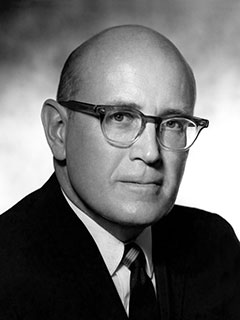 The University entered a new epoch, a time of reexamination and consolidation under its third president, Henry King Stanford. Stanford’s presidency was marked by further emphasis on research activity, additions to physical facilities, and reorganization of the University’s administrative structure. Several research centers and institutes were established, including the Center for Advanced International Studies (1964), the Institute of Molecular and Cellular Evolution (1964), the Center for Theoretical Studies (1965), and the Institute for the Study of Aging (1975). The Otto G. Richter Library, the James M. Cox Science Building, and four 12-story residence halls opened during his tenure. The Institute of Marine Science became the Rosenstiel School of Marine and Atmospheric Science in recognition of a record $12 million gift from the Rosenstiel Foundation. In 1976 when the University celebrated its 50th anniversary, the $129 million Mid-Century Capital Campaign was launched; in 1981 it closed six months ahead of schedule with more than $132 million raised.
The University entered a new epoch, a time of reexamination and consolidation under its third president, Henry King Stanford. Stanford’s presidency was marked by further emphasis on research activity, additions to physical facilities, and reorganization of the University’s administrative structure. Several research centers and institutes were established, including the Center for Advanced International Studies (1964), the Institute of Molecular and Cellular Evolution (1964), the Center for Theoretical Studies (1965), and the Institute for the Study of Aging (1975). The Otto G. Richter Library, the James M. Cox Science Building, and four 12-story residence halls opened during his tenure. The Institute of Marine Science became the Rosenstiel School of Marine and Atmospheric Science in recognition of a record $12 million gift from the Rosenstiel Foundation. In 1976 when the University celebrated its 50th anniversary, the $129 million Mid-Century Capital Campaign was launched; in 1981 it closed six months ahead of schedule with more than $132 million raised.
Edward T. Foote II (1981-2001)
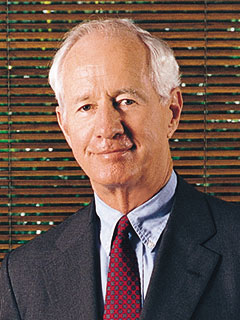 In 1981 Edward T. Foote II became the University's fourth president. He introduced a strategic plan, “Strategy for Excellence,” to move UM into the circle of prestigious private research universities; reduced enrollment and increased student selectivity; and average SAT scores of incoming freshmen increased by nearly 100 points. He strengthened the emphasis on academics, research, and teaching excellence, and sponsored research funding. Under his leadership, the University was elected to membership in Phi Beta Kappa, the nation’s oldest and most prestigious honor society; new schools of architecture and communication were created; and the University began and completed a series of renovations that converted standard student dormitories into a system of residential colleges. In addition, Foote was the catalyst behind the creation of the University’s strategic plan, a blueprint for the acceleration of the University’s excellence. The five-year $400 million Campaign for the University of Miami, launched in 1984, surpassed its goal in April 1988 and ended with $517.5 million raised.
In 1981 Edward T. Foote II became the University's fourth president. He introduced a strategic plan, “Strategy for Excellence,” to move UM into the circle of prestigious private research universities; reduced enrollment and increased student selectivity; and average SAT scores of incoming freshmen increased by nearly 100 points. He strengthened the emphasis on academics, research, and teaching excellence, and sponsored research funding. Under his leadership, the University was elected to membership in Phi Beta Kappa, the nation’s oldest and most prestigious honor society; new schools of architecture and communication were created; and the University began and completed a series of renovations that converted standard student dormitories into a system of residential colleges. In addition, Foote was the catalyst behind the creation of the University’s strategic plan, a blueprint for the acceleration of the University’s excellence. The five-year $400 million Campaign for the University of Miami, launched in 1984, surpassed its goal in April 1988 and ended with $517.5 million raised.
Donna E. Shalala (2001-2015)
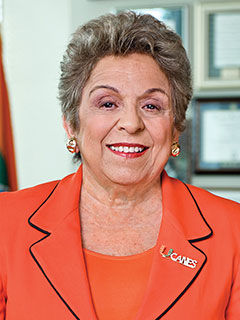 In 2001 Donna E. Shalala, former U.S. Secretary of Health and Human Services in the Clinton administration, became the fifth president and spearheaded extraordinary progress in all areas. Under her leadership, the University conducted two historic fundraising initiatives: Momentum: The Campaign for the University of Miami (publicly launched 2003) raised $1.4 billion; and Momentum2: The Breakthrough Campaign for the University of Miami (publicly launched 2012) raised $1.6 billion. The University experienced an extraordinary rise in the popular U.S. News & World Report’s annual Best Colleges ranking. In 2014, for the sixth year in a row, UM was ranked in the top 50; in 2001 it stood at No. 67. For a number of years U.S. News has listed several UM graduate programs in its America’s Best Graduate Schools rankings. The research enterprise grew significantly, to more than $330 million in sponsored grants and contracts in FY 2015 in support of more than 2,100 projects, with the Miller School of Medicine and School of Nursing and Health Studies leading the state in National Institutes of Health funding. Student selectivity for incoming freshmen reached an all-time high, with a mean SAT score of 1320; about half graduated in the top 5 percent of their high school class and 66 percent graduated in the top 10 percent.
In 2001 Donna E. Shalala, former U.S. Secretary of Health and Human Services in the Clinton administration, became the fifth president and spearheaded extraordinary progress in all areas. Under her leadership, the University conducted two historic fundraising initiatives: Momentum: The Campaign for the University of Miami (publicly launched 2003) raised $1.4 billion; and Momentum2: The Breakthrough Campaign for the University of Miami (publicly launched 2012) raised $1.6 billion. The University experienced an extraordinary rise in the popular U.S. News & World Report’s annual Best Colleges ranking. In 2014, for the sixth year in a row, UM was ranked in the top 50; in 2001 it stood at No. 67. For a number of years U.S. News has listed several UM graduate programs in its America’s Best Graduate Schools rankings. The research enterprise grew significantly, to more than $330 million in sponsored grants and contracts in FY 2015 in support of more than 2,100 projects, with the Miller School of Medicine and School of Nursing and Health Studies leading the state in National Institutes of Health funding. Student selectivity for incoming freshmen reached an all-time high, with a mean SAT score of 1320; about half graduated in the top 5 percent of their high school class and 66 percent graduated in the top 10 percent.
Julio Frenk (2015-2024)
 Julio Frenk became the sixth president of the University of Miami in August of 2015, helping to lead a nearly decade long period of excellence and continuous improvement across the enterprise.
Julio Frenk became the sixth president of the University of Miami in August of 2015, helping to lead a nearly decade long period of excellence and continuous improvement across the enterprise.
A former dean of the Harvard T.H. Chan School of Public Health and federal secretary of health of Mexico, under his leadership, the University was invited to join the prestigious Association of American University (AAU), a national organization of leading research universities, entry into which is by invitation.



 The University of Miami was chartered in 1925 by a group of citizens who felt an institution of higher learning was needed for the development of their young and growing community. By the fall of 1926, when the first class of 646 full-time students enrolled at the University of Miami, the land boom had collapsed and hopes for a speedy recovery were dashed by a major hurricane. In the next 15 years the University barely kept afloat. The University survived primarily due to the vision and persistence of its first president, Bowman F. Ashe (1926-52). Under his administration, the institution overcame bankruptcy, a reorganization, a world war, and then in the post-war years, experienced tremendous growth and expansion.
The University of Miami was chartered in 1925 by a group of citizens who felt an institution of higher learning was needed for the development of their young and growing community. By the fall of 1926, when the first class of 646 full-time students enrolled at the University of Miami, the land boom had collapsed and hopes for a speedy recovery were dashed by a major hurricane. In the next 15 years the University barely kept afloat. The University survived primarily due to the vision and persistence of its first president, Bowman F. Ashe (1926-52). Under his administration, the institution overcame bankruptcy, a reorganization, a world war, and then in the post-war years, experienced tremendous growth and expansion. A marine biologist by training, charter faculty member, and an assistant to President Ashe since 1929, Jay F. W. Pearson assumed the presidency in 1953 and presided during a decade of unprecedented growth. Total enrollment stood at over 10,000 in 1953 and increased to nearly 14,000 by the end of the Pearson presidency in 1962. New facilities and resources were added to keep pace with enrollment and strengthen the research enterprise. The University also added an undergraduate honors program, expanded the graduate programs to the doctoral level in a dozen fields, established a core curriculum for undergraduates, and vastly increased its research activity. Groundbreaking was held for the Ashe Administration Building and the Otto G. Richter Library, and first building for the law school was constructed. A great social change took place in 1961 when the Board of Trustees voted to admit qualified students without regard to race and color, ending the segregation that had been in place at UM since its opening and prompting other Florida institutions to make the same move.
A marine biologist by training, charter faculty member, and an assistant to President Ashe since 1929, Jay F. W. Pearson assumed the presidency in 1953 and presided during a decade of unprecedented growth. Total enrollment stood at over 10,000 in 1953 and increased to nearly 14,000 by the end of the Pearson presidency in 1962. New facilities and resources were added to keep pace with enrollment and strengthen the research enterprise. The University also added an undergraduate honors program, expanded the graduate programs to the doctoral level in a dozen fields, established a core curriculum for undergraduates, and vastly increased its research activity. Groundbreaking was held for the Ashe Administration Building and the Otto G. Richter Library, and first building for the law school was constructed. A great social change took place in 1961 when the Board of Trustees voted to admit qualified students without regard to race and color, ending the segregation that had been in place at UM since its opening and prompting other Florida institutions to make the same move. The University entered a new epoch, a time of reexamination and consolidation under its third president, Henry King Stanford. Stanford’s presidency was marked by further emphasis on research activity, additions to physical facilities, and reorganization of the University’s administrative structure. Several research centers and institutes were established, including the Center for Advanced International Studies (1964), the Institute of Molecular and Cellular Evolution (1964), the Center for Theoretical Studies (1965), and the Institute for the Study of Aging (1975). The Otto G. Richter Library, the James M. Cox Science Building, and four 12-story residence halls opened during his tenure. The Institute of Marine Science became the Rosenstiel School of Marine and Atmospheric Science in recognition of a record $12 million gift from the Rosenstiel Foundation. In 1976 when the University celebrated its 50th anniversary, the $129 million Mid-Century Capital Campaign was launched; in 1981 it closed six months ahead of schedule with more than $132 million raised.
The University entered a new epoch, a time of reexamination and consolidation under its third president, Henry King Stanford. Stanford’s presidency was marked by further emphasis on research activity, additions to physical facilities, and reorganization of the University’s administrative structure. Several research centers and institutes were established, including the Center for Advanced International Studies (1964), the Institute of Molecular and Cellular Evolution (1964), the Center for Theoretical Studies (1965), and the Institute for the Study of Aging (1975). The Otto G. Richter Library, the James M. Cox Science Building, and four 12-story residence halls opened during his tenure. The Institute of Marine Science became the Rosenstiel School of Marine and Atmospheric Science in recognition of a record $12 million gift from the Rosenstiel Foundation. In 1976 when the University celebrated its 50th anniversary, the $129 million Mid-Century Capital Campaign was launched; in 1981 it closed six months ahead of schedule with more than $132 million raised. In 1981 Edward T. Foote II became the University's fourth president. He introduced a strategic plan, “Strategy for Excellence,” to move UM into the circle of prestigious private research universities; reduced enrollment and increased student selectivity; and average SAT scores of incoming freshmen increased by nearly 100 points. He strengthened the emphasis on academics, research, and teaching excellence, and sponsored research funding. Under his leadership, the University was elected to membership in Phi Beta Kappa, the nation’s oldest and most prestigious honor society; new schools of architecture and communication were created; and the University began and completed a series of renovations that converted standard student dormitories into a system of residential colleges. In addition, Foote was the catalyst behind the creation of the University’s strategic plan, a blueprint for the acceleration of the University’s excellence. The five-year $400 million Campaign for the University of Miami, launched in 1984, surpassed its goal in April 1988 and ended with $517.5 million raised.
In 1981 Edward T. Foote II became the University's fourth president. He introduced a strategic plan, “Strategy for Excellence,” to move UM into the circle of prestigious private research universities; reduced enrollment and increased student selectivity; and average SAT scores of incoming freshmen increased by nearly 100 points. He strengthened the emphasis on academics, research, and teaching excellence, and sponsored research funding. Under his leadership, the University was elected to membership in Phi Beta Kappa, the nation’s oldest and most prestigious honor society; new schools of architecture and communication were created; and the University began and completed a series of renovations that converted standard student dormitories into a system of residential colleges. In addition, Foote was the catalyst behind the creation of the University’s strategic plan, a blueprint for the acceleration of the University’s excellence. The five-year $400 million Campaign for the University of Miami, launched in 1984, surpassed its goal in April 1988 and ended with $517.5 million raised. In 2001 Donna E. Shalala, former U.S. Secretary of Health and Human Services in the Clinton administration, became the fifth president and spearheaded extraordinary progress in all areas. Under her leadership, the University conducted two historic fundraising initiatives: Momentum: The Campaign for the University of Miami (publicly launched 2003) raised $1.4 billion; and Momentum2: The Breakthrough Campaign for the University of Miami (publicly launched 2012) raised $1.6 billion. The University experienced an extraordinary rise in the popular U.S. News & World Report’s annual Best Colleges ranking. In 2014, for the sixth year in a row, UM was ranked in the top 50; in 2001 it stood at No. 67. For a number of years U.S. News has listed several UM graduate programs in its America’s Best Graduate Schools rankings. The research enterprise grew significantly, to more than $330 million in sponsored grants and contracts in FY 2015 in support of more than 2,100 projects, with the Miller School of Medicine and School of Nursing and Health Studies leading the state in National Institutes of Health funding. Student selectivity for incoming freshmen reached an all-time high, with a mean SAT score of 1320; about half graduated in the top 5 percent of their high school class and 66 percent graduated in the top 10 percent.
In 2001 Donna E. Shalala, former U.S. Secretary of Health and Human Services in the Clinton administration, became the fifth president and spearheaded extraordinary progress in all areas. Under her leadership, the University conducted two historic fundraising initiatives: Momentum: The Campaign for the University of Miami (publicly launched 2003) raised $1.4 billion; and Momentum2: The Breakthrough Campaign for the University of Miami (publicly launched 2012) raised $1.6 billion. The University experienced an extraordinary rise in the popular U.S. News & World Report’s annual Best Colleges ranking. In 2014, for the sixth year in a row, UM was ranked in the top 50; in 2001 it stood at No. 67. For a number of years U.S. News has listed several UM graduate programs in its America’s Best Graduate Schools rankings. The research enterprise grew significantly, to more than $330 million in sponsored grants and contracts in FY 2015 in support of more than 2,100 projects, with the Miller School of Medicine and School of Nursing and Health Studies leading the state in National Institutes of Health funding. Student selectivity for incoming freshmen reached an all-time high, with a mean SAT score of 1320; about half graduated in the top 5 percent of their high school class and 66 percent graduated in the top 10 percent.  Julio Frenk became the sixth president of the University of Miami in August of 2015, helping to lead a nearly decade long period of excellence and continuous improvement across the enterprise.
Julio Frenk became the sixth president of the University of Miami in August of 2015, helping to lead a nearly decade long period of excellence and continuous improvement across the enterprise.